Bees are sticklers for strict work schedule
Researchers from Queen Mary University of London in the UK have discovered that bumblebees are strict about when and how long they work. Presented in the journal BMC Biology, the research is an outcome of the LAPBIAT ('Lapland atmosphere-biosphere facility') project, which received almost EUR 1.5 million under the Research Infrastructures action of the EU's Sixth Framework Programme (FP6) to investigate the interactions between the ecosystems around or north of the Arctic Circle. Professor Lars Chittka and PhD student Ralph Stelzer conducted their study at a research station in northern Finland. They tagged 1,049 worker bees with radio identifiers in order to keep an eye on their movements - specifically their circadian foraging rhythms - during the permanent daylight of the Arctic summer. The researchers speculated that because of the constant daylight, the bumblebee foragers would use the extra working time to their advantage and maximise intake and colony growth. Past studies have shown that the circadian rhythms of social insects are fairly flexible, and that these creatures can alter the expression of clock genes to fit the demands of the colony. They tested the foraging rhythms of bumblebee (Bombus terrestris and B. pascuorum) colonies in the northern part of Finland during the summer season, the period when the sun stays above the horizon for several weeks. Native bumblebees and a group of bee colonies imported into the Arctic were assessed. Both species worked a day shift, and the most intense activity was recorded around midday. The bees retired to their nests a few hours before midnight, according to the researchers. So the bees did not keep active for the entire 24-hour period. 'We found that bees do not naturally take advantage of this opportunity, suggesting that there is some benefit to an 'overnight break,' explained Mr Stelzer. The researchers discovered that the bumblebee foragers exhibited robust diurnal rhythms instead. Around 95% of the tested B. Terrestris workers showed strong diurnal rhythms with a mean period of 23.8 hours. Most of the foraging activity occurred between 08:00 and 23:00. The B. pascuorum workers, meanwhile, carried out most of their foraging activity between 06:00 and 22:00. The researchers postulated that the bees use some external cue to tell the time in the absence of day and night cues. Based on their research, they said that insects are probably sensitive to light intensity and quality or changes in temperature. 'Daily fluctuations in the spectral composition of light, especially in the UV (ultraviolet) range, could also be responsible for synchronising the circadian clock of the foragers under the continuous daylight conditions,' the authors write. 'Despite the light, temperatures do fall during the Arctic 'night', so it may be that the bees need to return to their nests in order to warm their brood,' the researchers commented. 'Also, it has been suggested that a period of sleep helps bees to remember information gained during the day's foraging.'
Countries
Germany, France, United Kingdom



